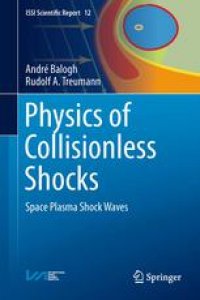
Ebook: Physics of Collisionless Shocks: Space Plasma Shock Waves
- Genre: Physics // Plasma Physics
- Tags: Extraterrestrial Physics Space Sciences, Astrophysics and Astroparticles, Plasma Physics
- Series: ISSI Scientific Report Series 12
- Year: 2013
- Publisher: Springer-Verlag New York
- Edition: 1
- Language: English
- pdf
The present book provides a contemporary systematic treatment of shock waves in high-temperature collisionless plasmas as are encountered in near Earth space and in Astrophysics. It consists of two parts. Part I develops the complete theory of shocks in dilute hot plasmas under the assumption of absence of collisions among the charged particles when the interaction is mediated solely by the self-consistent electromagnetic fields. Such shocks are naturally magnetised implying that the magnetic field plays an important role in their evolution and dynamics. This part treats subcritical shocks which dissipate flow energy by generating anomalous resistance or viscosity. The main emphasis is, however, on super-critical shocks where the anomalous dissipation is insufficient to retard the upstream flow. These shocks, depending on the direction of the upstream magnetic field, are distinguished as quasi-perpendicular and quasi-parallel shocks which exhibit different behaviours, reflecting particles back upstream and generating high electromagnetic wave intensities. Particle acceleration and turbulence at such shocks become possible and important. Part II treats planetary bow shocks and the famous Heliospheric Termination shock as examples of two applications of the theory developed in part I.
The present book provides a contemporary systematic treatment of shock waves in high-temperature collisionless plasmas as are encountered in near Earth space and in Astrophysics. It consists of two parts. Part I develops the complete theory of shocks in dilute hot plasmas under the assumption of absence of collisions among the charged particles when the interaction is mediated solely by the self-consistent electromagnetic fields. Such shocks are naturally magnetised implying that the magnetic field plays an important role in their evolution and dynamics. This part treats both subcritical shocks, which dissipate flow energy by generating anomalous resistance or viscosity, and supercritical shocks. The main emphasis is, however, on super-critical shocks where the anomalous dissipation is insufficient to retard the upstream flow. These shocks, depending on the direction of the upstream magnetic field, are distinguished as quasi-perpendicular and quasi-parallel shocks which exhibit different behaviours, reflecting particles back upstream and generating high electromagnetic wave intensities. Particle acceleration and turbulence at such shocks become possible and important. Part II treats planetary bow shocks and the famous Heliospheric Termination shock as examples of two applications of the theory developed in Part I.
The present book provides a contemporary systematic treatment of shock waves in high-temperature collisionless plasmas as are encountered in near Earth space and in Astrophysics. It consists of two parts. Part I develops the complete theory of shocks in dilute hot plasmas under the assumption of absence of collisions among the charged particles when the interaction is mediated solely by the self-consistent electromagnetic fields. Such shocks are naturally magnetised implying that the magnetic field plays an important role in their evolution and dynamics. This part treats both subcritical shocks, which dissipate flow energy by generating anomalous resistance or viscosity, and supercritical shocks. The main emphasis is, however, on super-critical shocks where the anomalous dissipation is insufficient to retard the upstream flow. These shocks, depending on the direction of the upstream magnetic field, are distinguished as quasi-perpendicular and quasi-parallel shocks which exhibit different behaviours, reflecting particles back upstream and generating high electromagnetic wave intensities. Particle acceleration and turbulence at such shocks become possible and important. Part II treats planetary bow shocks and the famous Heliospheric Termination shock as examples of two applications of the theory developed in Part I.
Content:
Front Matter....Pages I-XII
Front Matter....Pages 1-1
Introduction....Pages 3-5
The Shock Problem....Pages 7-43
Basic Equations and Models....Pages 45-123
Collisionless Subcritical Shocks....Pages 125-148
Quasi-perpendicular Supercritical Shocks....Pages 149-220
Quasi-parallel Supercritical Shocks....Pages 221-331
Particle Acceleration....Pages 333-398
Final Remarks....Pages 399-403
Front Matter....Pages 405-405
Introduction....Pages 407-409
Planetary Bow Shocks....Pages 411-461
The Heliospheric Termination Shock....Pages 463-494
Back Matter....Pages 495-500
The present book provides a contemporary systematic treatment of shock waves in high-temperature collisionless plasmas as are encountered in near Earth space and in Astrophysics. It consists of two parts. Part I develops the complete theory of shocks in dilute hot plasmas under the assumption of absence of collisions among the charged particles when the interaction is mediated solely by the self-consistent electromagnetic fields. Such shocks are naturally magnetised implying that the magnetic field plays an important role in their evolution and dynamics. This part treats both subcritical shocks, which dissipate flow energy by generating anomalous resistance or viscosity, and supercritical shocks. The main emphasis is, however, on super-critical shocks where the anomalous dissipation is insufficient to retard the upstream flow. These shocks, depending on the direction of the upstream magnetic field, are distinguished as quasi-perpendicular and quasi-parallel shocks which exhibit different behaviours, reflecting particles back upstream and generating high electromagnetic wave intensities. Particle acceleration and turbulence at such shocks become possible and important. Part II treats planetary bow shocks and the famous Heliospheric Termination shock as examples of two applications of the theory developed in Part I.
Content:
Front Matter....Pages I-XII
Front Matter....Pages 1-1
Introduction....Pages 3-5
The Shock Problem....Pages 7-43
Basic Equations and Models....Pages 45-123
Collisionless Subcritical Shocks....Pages 125-148
Quasi-perpendicular Supercritical Shocks....Pages 149-220
Quasi-parallel Supercritical Shocks....Pages 221-331
Particle Acceleration....Pages 333-398
Final Remarks....Pages 399-403
Front Matter....Pages 405-405
Introduction....Pages 407-409
Planetary Bow Shocks....Pages 411-461
The Heliospheric Termination Shock....Pages 463-494
Back Matter....Pages 495-500
....